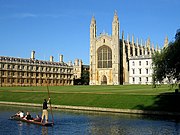Universities and learning institutions

The body responsible for state education in general up to the age of 19, in the United Kingdom is the Department for Children, Schools and Families—this body directly controls state schools in England. Funded through taxation state-run schools are attended by approximately 93% of English schoolchildren. There is a minority of faith schools, mostly Church of England or Catholic Church. Between three and four is nursery school, four and eleven is primary school, and eleven to sixteen is secondary school, with an option for a two-year extension to attend sixth form college. Although most English secondary schools are comprehensive, there are selective intake grammar schools, to which entrance is subject to passing the eleven plus exam. Around 7.2% of English schoolchildren attend private schools, which are funded by private sources. Standards are monitored by regular inspections of state-funded schools by the Office for Standards in Education and of private schools by the Independent Schools Inspectorate.

After finishing compulsory education, pupils take a GCSE examination, following which they may decide to continue in further education and attend a further education college. Students normally enter universities in the United Kingdom from 18 onwards, where they study for an academic degree. England has more than 90 state-funded universities, which are monitored by the Department for Innovation, Universities and Skills. Students are generally entitled to student loans for maintenance.The first degree offered to undergraduates is the Bachelor's degree, which usually takes three years to complete. Students are then eligible for a postgraduate degree, a Master's degree, taking one year, or a Doctorate degree, which takes three. England has a history of promoting education, and its top institutions are internationally respected. The most acclaimed English universities are Oxford and Cambridge. The King's School, Canterbury and The King's School, Rochester are the oldest schools in the English-speaking world. Many of England's more well-known schools, such as Winchester College, Eton College, St Paul's School, Rugby School, and Harrow School are fee-paying institutions.
Science, engineering and innovation

Prominent English figures from the field of science and mathematics include Sir Isaac Newton, Michael Faraday, Robert Hooke, Robert Boyle, Joseph Priestley, J. J. Thomson, Charles Babbage, Charles Darwin, Stephen Hawking, Christopher Wren, Alan Turing, Francis Crick, Joseph Lister, Tim Berners-Lee, Andrew Wiles and Richard Dawkins. Experts claim that the earliest concept of a metric system was invented by John Wilkins, first secretary of the Royal Society in 1668. As birthplace of the Industrial Revolution, England was home to many significant inventors during the late 18th and early 19th century. Famous English engineers include Isambard Kingdom Brunel, best known for the creation of the Great Western Railway, a series of famous steamships, and numerous important bridges, hence revolutionising public transport and modern-day engineering.
Inventions and discoveries of the English include; the first industrial spinning machine, the first computer and the first modern computer, the World Wide Web along with HTTP and HTML, the first successful human blood transfusion, the vacuum cleaner, the lawnmower, the seat belt, the hovercraft, the electric motor, the microphone, steam engines, and theories such as the Darwinian theory of evolution and atomic theory.[181] Newton developed the ideas of universal gravitation, Newtonian mechanics, and infinitesimal calculus, and Robert Hooke his eponymously named law of elasticity. Other inventions include the iron plate railway, the thermosiphon, tarmac, the rubber band, the mousetrap, "cat's eye" road safety device, joint development of the light bulb, steam locomotives, the seed drill, the jet engine and many modern techniques and technologies used in precision engineering.

No comments:
Post a Comment